Abstract
Porphyrias are relatively uncommon inherited or acquired disorders in which clinical manifestations are attributable to a disturbance of heme synthesis (porphyrin metabolism), usually in association with endogenous or exogenous stressors. Porphyrias are characterized by elevations of heme precursors in blood, urine, and/or stool. A number of chemicals, particularly metals and halogenated hydrocarbons, induce disturbances of heme synthesis in experimental animals. Certain chemicals have also been linked to porphyria or porphyrinuria in humans, generally involving chronic industrial exposures or environmental exposures much higher than those usually encountered. A noteworthy example is the Turkish epidemic of porphyria cutanea tarda produced by accidental ingestion of wheat treated with the fungicide hexachlorobenzene. Measurements of excreted heme precursors have the potential to serve as biological markers for harmful but preclinical effects of certain chemical exposures; this potential warrants further research and applied field studies. It has been hypothesized that several otherwise unexplained chemical-associated illnesses, such as multiple chemical sensitivity syndrome, may represent mild chronic cases of porphyria or other acquired abnormalities in heme synthesis. This review concludes that, although it is reasonable to consider such hypotheses, there is currently no convincing evidence that these illnesses are mediated by a disturbance of heme synthesis; it is premature or unfounded to base clinical management on such explanations unless laboratory data are diagnostic for porphyria. This review discusses the limitations of laboratory measures of heme synthesis, and diagnostic guidelines are provided to assist in evaluating the symptomatic individual suspected of having a porphyria.
Full text
PDF
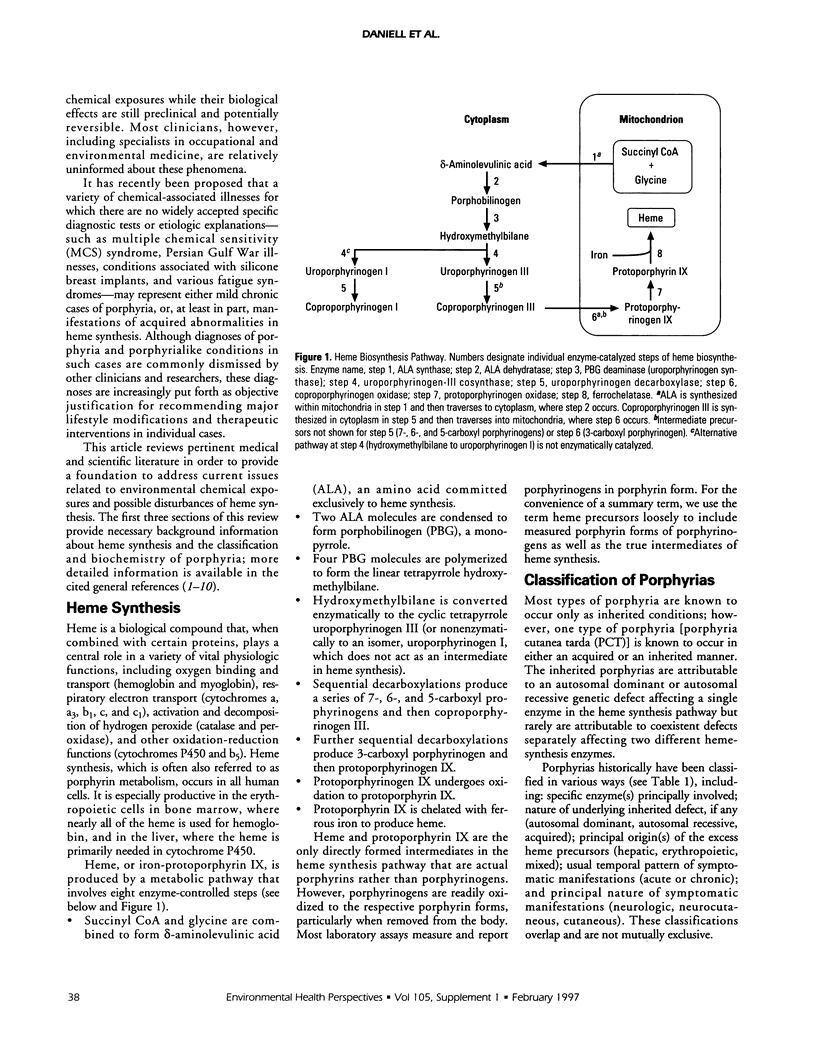


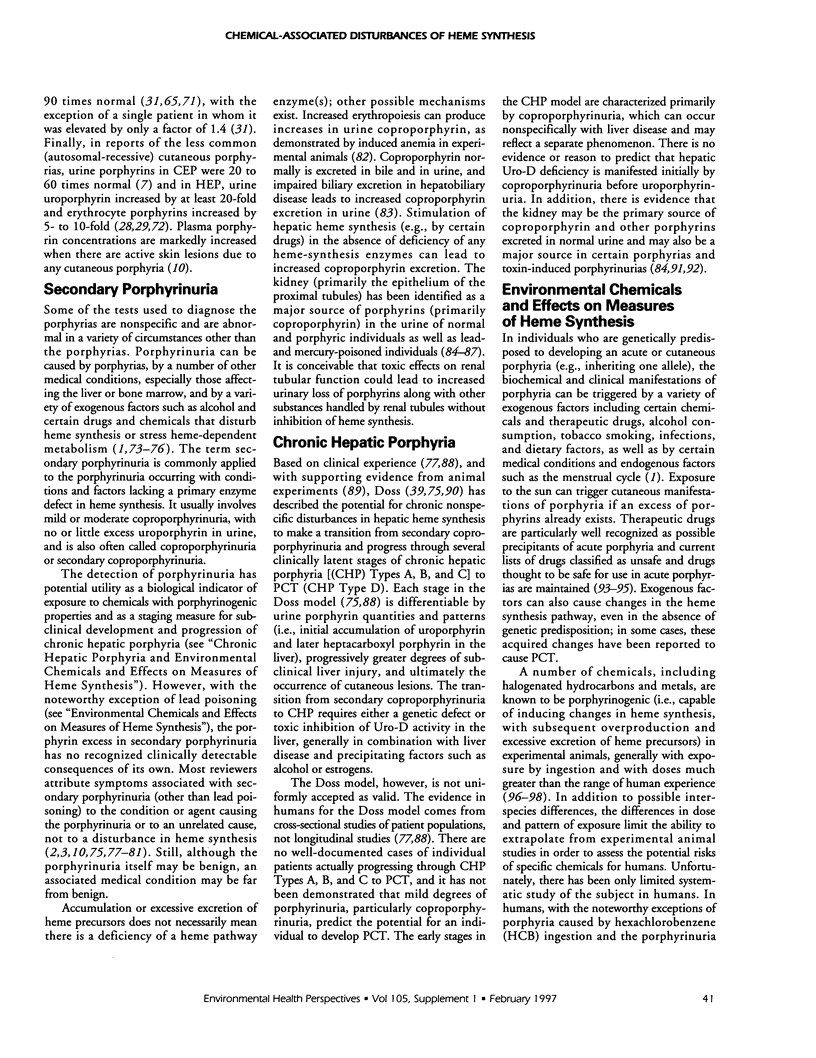
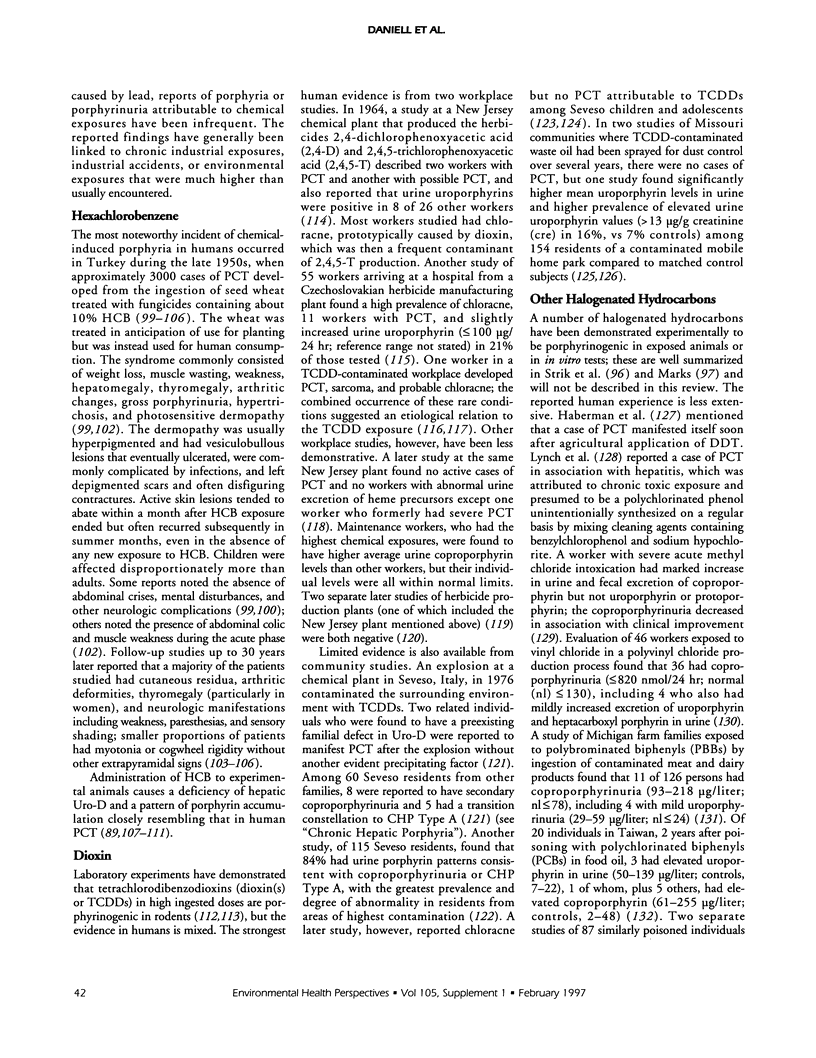

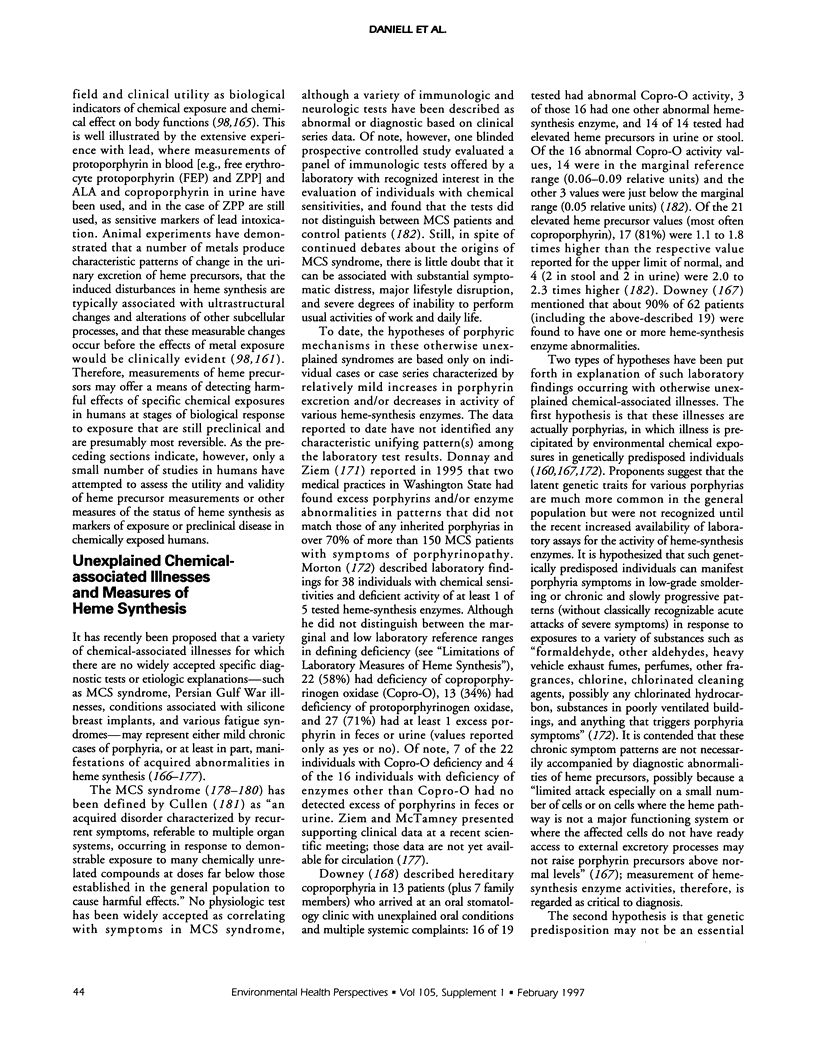
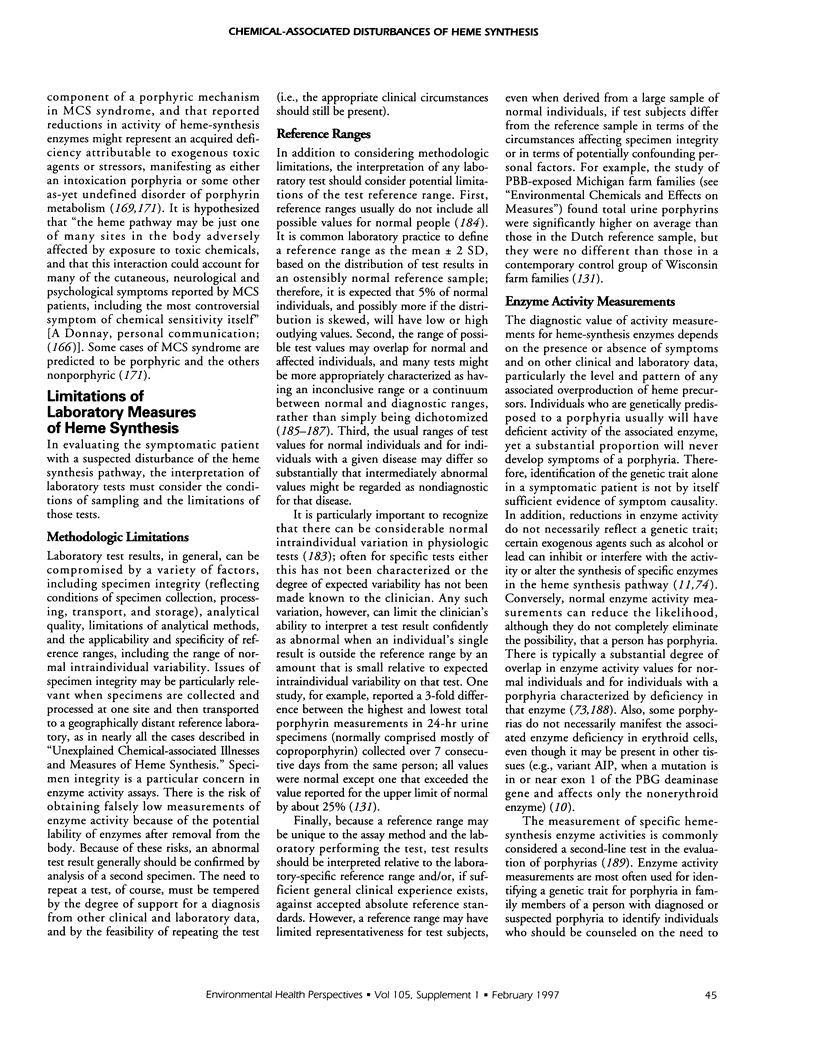
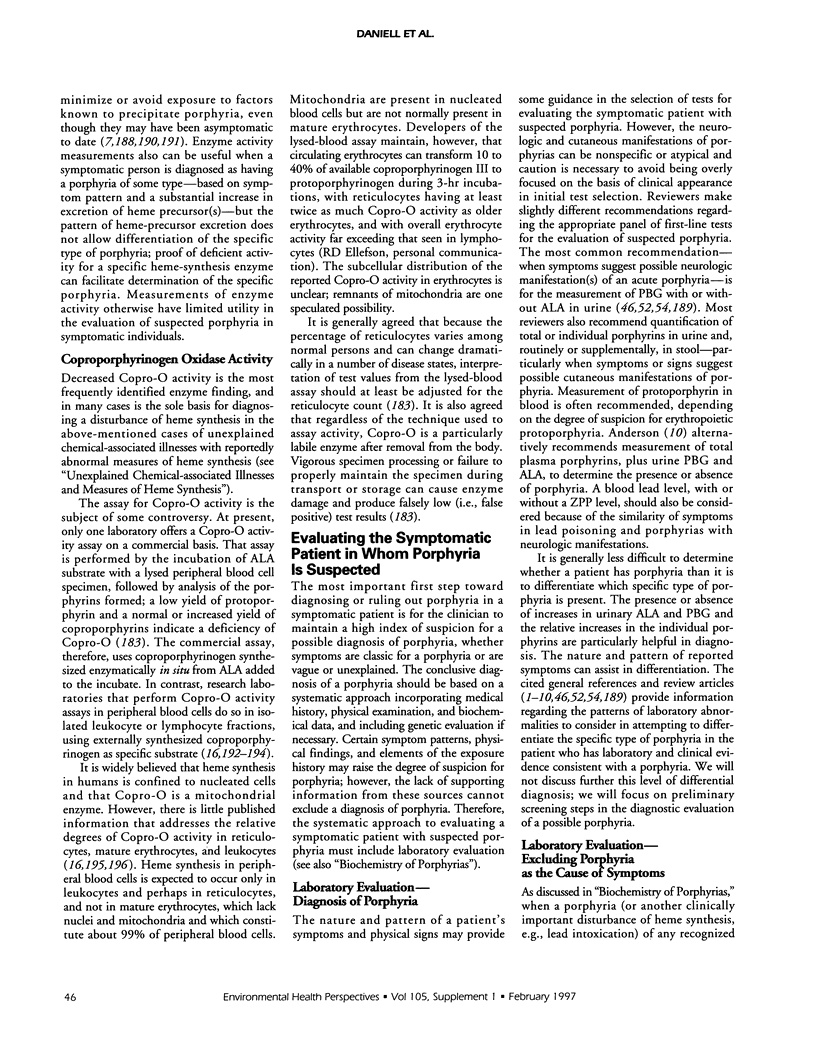

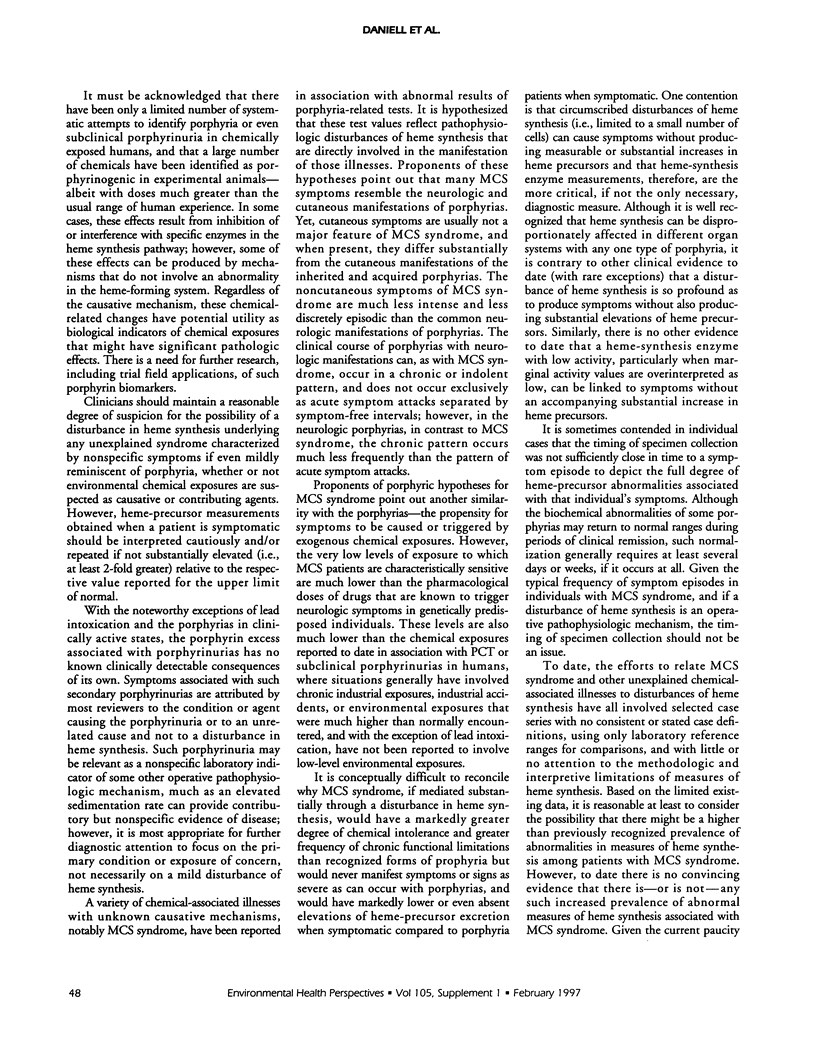
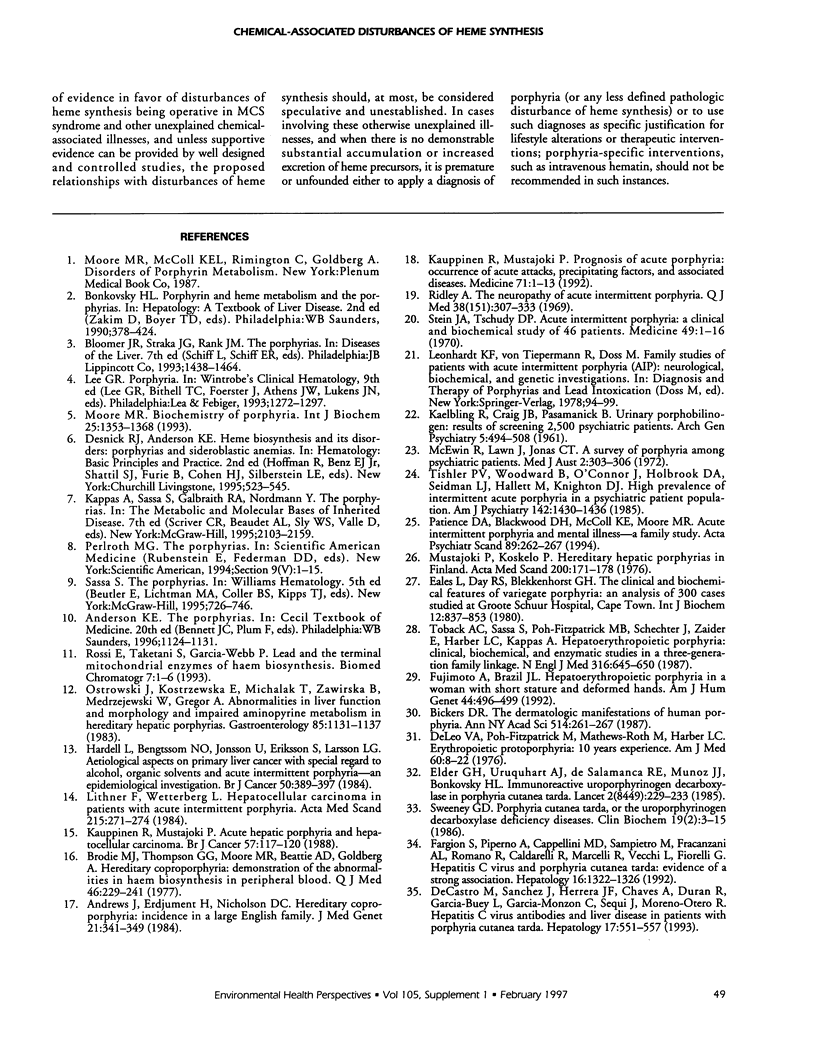
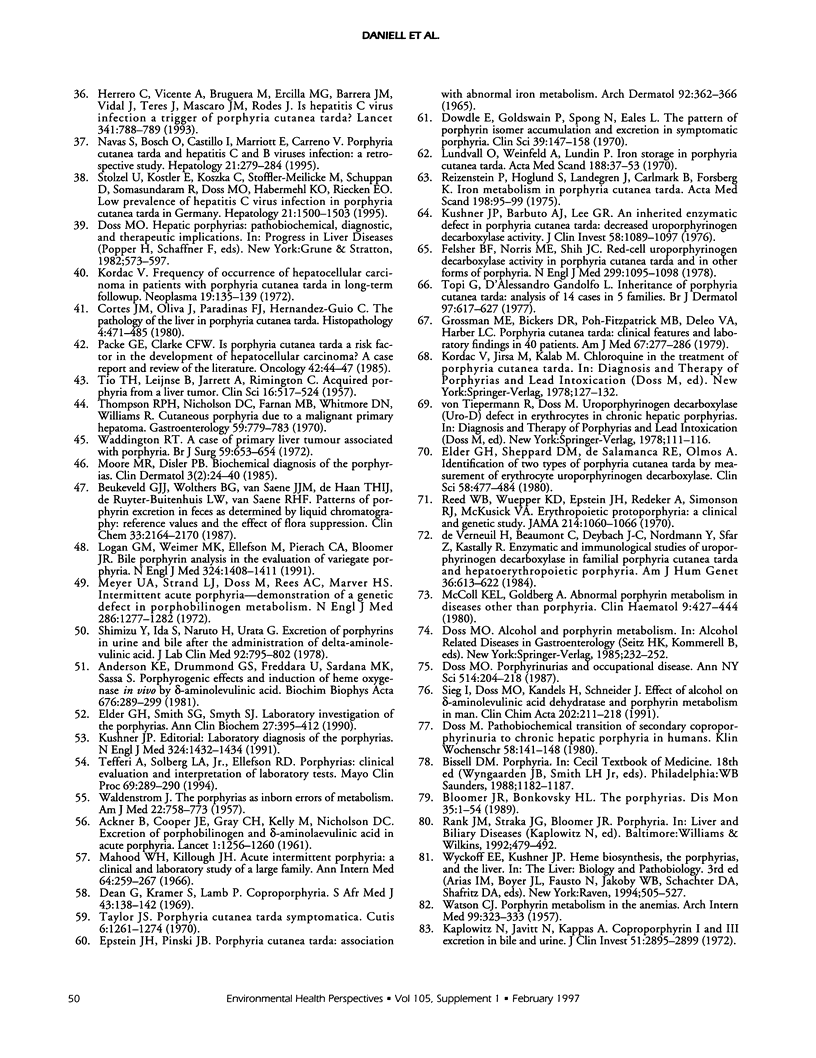

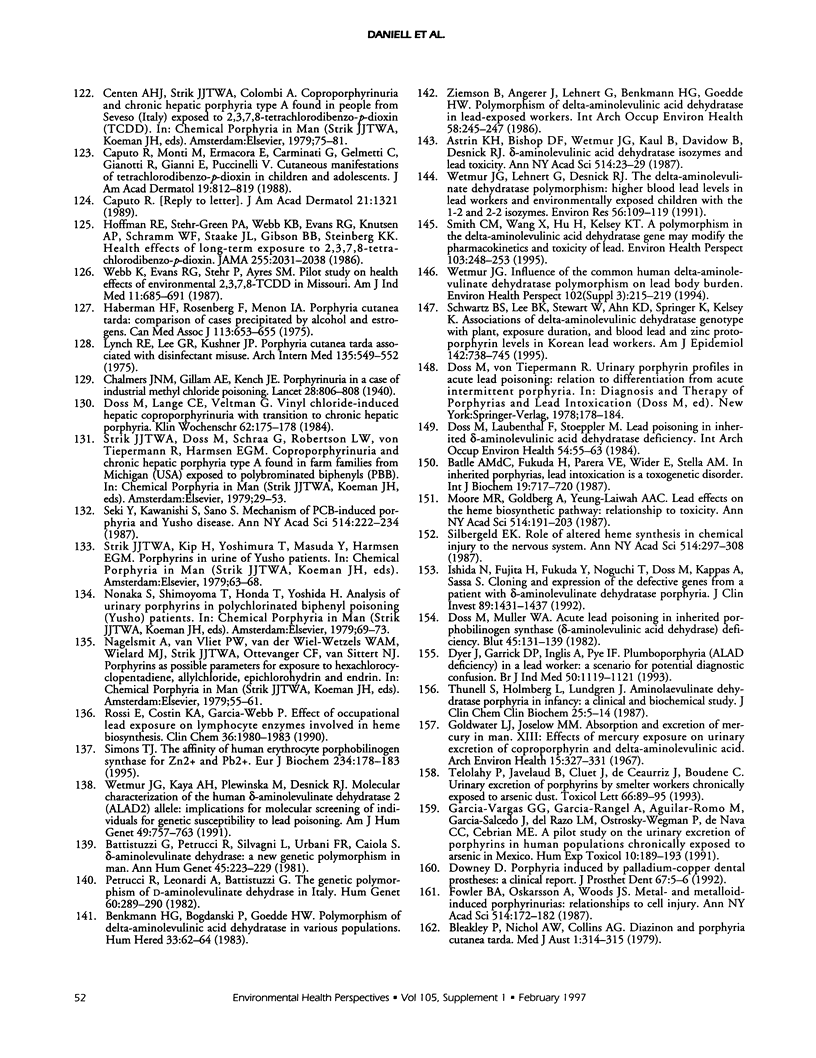
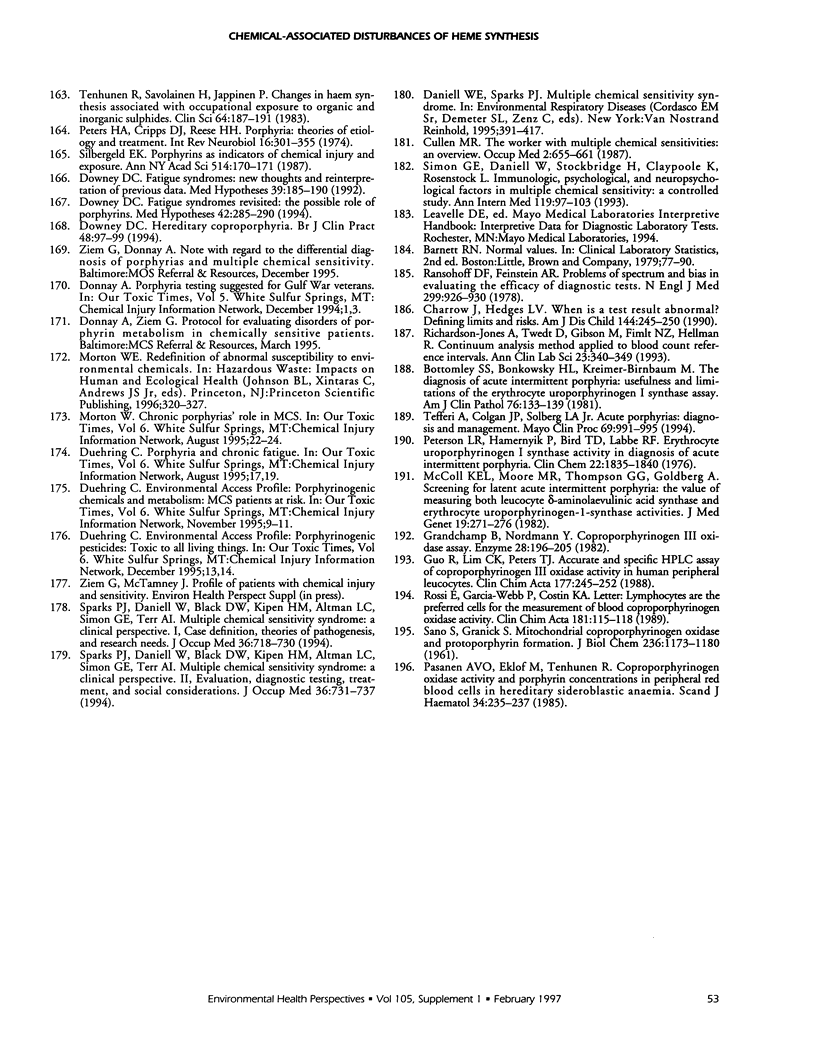
Selected References
These references are in PubMed. This may not be the complete list of references from this article.
- ACKNER B., COOPER J. E., GRAY C. H., KELLY M., NICHOLSON D. C. Excretion of porphobilinogen and 5-aminolaevulinic acid in acute porphyria. Lancet. 1961 Jun 10;1(7189):1256–1260. doi: 10.1016/s0140-6736(61)92764-7. [DOI] [PubMed] [Google Scholar]
- Anderson K. E., Drummond G. S., Freddara U., Sardana M. K., Sassa S. Porphyrogenic effects and induction of heme oxygenase in vivo by delta-aminolevulinic acid. Biochim Biophys Acta. 1981 Sep 4;676(3):289–299. doi: 10.1016/0304-4165(81)90162-8. [DOI] [PubMed] [Google Scholar]
- Andrews J., Erdjument H., Nicholson D. C. Hereditary coproporphyria: incidence in a large English family. J Med Genet. 1984 Oct;21(5):341–349. doi: 10.1136/jmg.21.5.341. [DOI] [PMC free article] [PubMed] [Google Scholar]
- Astrin K. H., Bishop D. F., Wetmur J. G., Kaul B., Davidow B., Desnick R. J. delta-Aminolevulinic acid dehydratase isozymes and lead toxicity. Ann N Y Acad Sci. 1987;514:23–29. doi: 10.1111/j.1749-6632.1987.tb48757.x. [DOI] [PubMed] [Google Scholar]
- BLEIBERG J., WALLEN M., BRODKIN R., APPLEBAUM I. L. INDUSTRIALLY ACQUIRED PORPHYRIA. Arch Dermatol. 1964 Jun;89:793–797. doi: 10.1001/archderm.1964.01590300021006. [DOI] [PubMed] [Google Scholar]
- Batlle A. M., Fukuda H., Parera V. E., Wider E., Stella A. M. In inherited porphyrias, lead intoxication is a toxogenetic disorder. Int J Biochem. 1987;19(8):717–720. doi: 10.1016/0020-711x(87)90086-3. [DOI] [PubMed] [Google Scholar]
- Battistuzzi G., Petrucci R., Silvagni L., Urbani F. R., Caiola S. delta-Aminolevulinate dehydrase: a new genetic polymorphism in man. Ann Hum Genet. 1981 Jul;45(Pt 3):223–229. doi: 10.1111/j.1469-1809.1981.tb00333.x. [DOI] [PubMed] [Google Scholar]
- Benkmann H. G., Bogdanski P., Goedde H. W. Polymorphism of delta-aminolevulinic acid dehydratase in various populations. Hum Hered. 1983;33(1):62–64. doi: 10.1159/000153351. [DOI] [PubMed] [Google Scholar]
- Beukeveld G. J., Wolthers B. G., van Saene J. J., de Haan T. H., de Ruyter-Buitenhuis L. W., van Saene R. H. Patterns of porphyrin excretion in feces as determined by liquid chromatography; reference values and the effect of flora suppression. Clin Chem. 1987 Dec;33(12):2164–2170. [PubMed] [Google Scholar]
- Bickers D. R. The dermatologic manifestations of human porphyria. Ann N Y Acad Sci. 1987;514:261–267. doi: 10.1111/j.1749-6632.1987.tb48781.x. [DOI] [PubMed] [Google Scholar]
- Bleakley P., Nichol A. W., Collins A. G. Diazinon and porphyria cutanea tarda. Med J Aust. 1979 Apr 21;1(8):314–315. doi: 10.5694/j.1326-5377.1979.tb112123.x. [DOI] [PubMed] [Google Scholar]
- Bloomer J. R., Bonkovsky H. L. The porphyrias. Dis Mon. 1989 Jan;35(1):1–54. doi: 10.1016/0011-5029(89)90003-5. [DOI] [PubMed] [Google Scholar]
- Bottomley S. S., Bonkowsky H. L., Kreimer-Birnbaum M. The diagnosis of acute intermittent porphyria. Usefulness and limitations of the erythrocyte uroporphyrinogen I synthase assay. Am J Clin Pathol. 1981 Aug;76(2):133–139. doi: 10.1093/ajcp/76.2.133. [DOI] [PubMed] [Google Scholar]
- Brodie M. J., Thompson G. G., Moore M. R., Beattie A. D., Goldberg A. Hereditary coproporphyria. Demonstration of the abnormalities in haem biosynthesis in peripheral blood. Q J Med. 1977 Apr;46(182):229–241. [PubMed] [Google Scholar]
- CAN C., NIGOGOSYAN G. Acquired toxic porphyria cutanea tarda due to hexachlorobenzene. Report of 348 cases caused by this fungicide. JAMA. 1963 Jan 12;183:88–91. [PubMed] [Google Scholar]
- Calvert G. M., Sweeney M. H., Fingerhut M. A., Hornung R. W., Halperin W. E. Evaluation of porphyria cutanea tarda in U.S. workers exposed to 2,3,7,8-tetrachlorodibenzo-p-dioxin. Am J Ind Med. 1994 Apr;25(4):559–571. doi: 10.1002/ajim.4700250410. [DOI] [PubMed] [Google Scholar]
- Caputo R., Monti M., Ermacora E., Carminati G., Gelmetti C., Gianotti R., Gianni E., Puccinelli V. Cutaneous manifestations of tetrachlorodibenzo-p-dioxin in children and adolescents. Follow-up 10 years after the Seveso, Italy, accident. J Am Acad Dermatol. 1988 Nov;19(5 Pt 1):812–819. doi: 10.1016/s0190-9622(88)70238-8. [DOI] [PubMed] [Google Scholar]
- Centers for Disease Control (CDC) Porphyria cutanea tarda and sarcoma in a worker exposed to 2, 3, 7, 8-tetrachlorodibenzodioxin--Missouri. MMWR Morb Mortal Wkly Rep. 1984 Mar 2;33(8):113–114. [PubMed] [Google Scholar]
- Charrow J., Hedges L. V. When is a test result abnormal? Defining limits and risks. Am J Dis Child. 1990 Feb;144(2):245–250. doi: 10.1001/archpedi.1990.02150260125045. [DOI] [PubMed] [Google Scholar]
- Cortés J. M., Oliva H., Paradinas F. J., Hernandez-Guío C. The pathology of the liver in porphyria cutanea tarda. Histopathology. 1980 Sep;4(5):471–485. doi: 10.1111/j.1365-2559.1980.tb02942.x. [DOI] [PubMed] [Google Scholar]
- Cullen M. R. The worker with multiple chemical sensitivities: an overview. Occup Med. 1987 Oct-Dec;2(4):655–661. [PubMed] [Google Scholar]
- DOGRAMACI I. PORPHYRIAS AND PORPHYRIN METABOLISM, WITH SPECIAL REFERENCE TO PORPHYRIA IN CHILDHOOD. Adv Pediatr. 1964;13:11–63. [PubMed] [Google Scholar]
- Day R. S., Blekkenhorst G. H., Eales L. Drug induced acute porphyric episodes in rats. Int J Biochem. 1980;12(5-6):1007–1011. doi: 10.1016/0020-711x(80)90203-7. [DOI] [PubMed] [Google Scholar]
- Day R. S., Eales L., Disler P. B. Porphyrias and the kidney. Nephron. 1981;28(6):261–267. doi: 10.1159/000182215. [DOI] [PubMed] [Google Scholar]
- DeCastro M., Sánchez J., Herrera J. F., Cháves A., Durán R., García-Buey L., García-Monzón C., Sequí J., Moreno-Otero R. Hepatitis C virus antibodies and liver disease in patients with porphyria cutanea tarda. Hepatology. 1993 Apr;17(4):551–557. doi: 10.1002/hep.1840170405. [DOI] [PubMed] [Google Scholar]
- DeLeo V. A., Poh-Fitzpatrick M., Mathews-Roth M., Harber L. C. Erythropoietic protoporphyria. 10 years experience. Am J Med. 1976 Jan;60(1):8–22. doi: 10.1016/0002-9343(76)90528-3. [DOI] [PubMed] [Google Scholar]
- Doss M. O. Hepatic porphyrias: pathobiochemical, diagnostic, and therapeutic implications. Prog Liver Dis. 1982;7:573–597. [PubMed] [Google Scholar]
- Doss M. O. Porphyrinurias and occupational disease. Ann N Y Acad Sci. 1987;514:204–218. doi: 10.1111/j.1749-6632.1987.tb48775.x. [DOI] [PubMed] [Google Scholar]
- Doss M., Lange C. E., Veltman G. Vinyl chloride-induced hepatic coproporphyrinuria with transition to chronic hepatic porphyria. Klin Wochenschr. 1984 Feb 15;62(4):175–178. doi: 10.1007/BF01731640. [DOI] [PubMed] [Google Scholar]
- Doss M., Laubenthal F., Stoeppler M. Lead poisoning in inherited delta-aminolevulinic acid dehydratase deficiency. Int Arch Occup Environ Health. 1984;54(1):55–63. doi: 10.1007/BF00378728. [DOI] [PubMed] [Google Scholar]
- Doss M., Müller W. A. Acute lead poisoning in inherited porphobilinogen synthase (delta-aminolevulinic acid dehydrase) deficiency. Blut. 1982 Aug;45(2):131–139. doi: 10.1007/BF00319941. [DOI] [PubMed] [Google Scholar]
- Doss M. Pathobiochemical transition of secondary coproporphyrinuria to chronic hepatic porphyria in humans. Klin Wochenschr. 1980 Feb 1;58(3):141–148. doi: 10.1007/BF01477271. [DOI] [PubMed] [Google Scholar]
- Doss M., Sauer H., von Tiepermann R., Colombi A. M. Development of chronic hepatic porphyria (porphyria cutanea tarda) with inherited uroporphyrinogen decarboxylase deficiency under exposure to dioxin. Int J Biochem. 1984;16(4):369–373. doi: 10.1016/0020-711x(84)90134-4. [DOI] [PubMed] [Google Scholar]
- Doss M., Schermuly E., Koss G. Hexachlorobenzene porphyria in rats as a model for human chronic hepatic porphyrias. Ann Clin Res. 1976;8 (Suppl 17):171–181. [PubMed] [Google Scholar]
- Dowdle E., Goldswain P., Spong N., Eales L. The pattern of porphyrin isomer accumulation and excretion in symptomatic porphyria. Clin Sci. 1970 Aug;39(2):147–158. doi: 10.1042/cs0390147. [DOI] [PubMed] [Google Scholar]
- Downey D. C. Fatigue syndromes revisited: the possible role of porphyrins. Med Hypotheses. 1994 May;42(5):285–290. doi: 10.1016/0306-9877(94)90001-9. [DOI] [PubMed] [Google Scholar]
- Downey D. C. Fatigue syndromes: new thoughts and reinterpretation of previous data. Med Hypotheses. 1992 Oct;39(2):185–190. doi: 10.1016/0306-9877(92)90184-e. [DOI] [PubMed] [Google Scholar]
- Downey D. C. Hereditary coproporphyria. Br J Clin Pract. 1994 Mar-Apr;48(2):97–99. [PubMed] [Google Scholar]
- Downey D. Porphyria induced by palladium-copper dental prostheses: a clinical report. J Prosthet Dent. 1992 Jan;67(1):5–6. doi: 10.1016/0022-3913(92)90037-b. [DOI] [PubMed] [Google Scholar]
- Dyer J., Garrick D. P., Inglis A., Pye I. F. Plumboporphyria (ALAD deficiency) in a lead worker: a scenario for potential diagnostic confusion. Br J Ind Med. 1993 Dec;50(12):1119–1121. doi: 10.1136/oem.50.12.1119. [DOI] [PMC free article] [PubMed] [Google Scholar]
- Eales L., Day R. S., Blekkenhorst G. H. The clinical and biochemical features of variegate porphyria: an analysis of 300 cases studied at Groote Schuur Hospital, Cape Town. Int J Biochem. 1980;12(5-6):837–853. doi: 10.1016/0020-711x(80)90173-1. [DOI] [PubMed] [Google Scholar]
- Elder G. H., Sheppard D. M., De Salamanca R. E., Olmos A. Identification of two types of porphyria cutanea tarda by measurement of erythrocyte uroporphyrinogen decarboxylase. Clin Sci (Lond) 1980 Jun;58(6):477–484. doi: 10.1042/cs0580477. [DOI] [PubMed] [Google Scholar]
- Elder G. H., Smith S. G., Smyth S. J. Laboratory investigation of the porphyrias. Ann Clin Biochem. 1990 Sep;27(Pt 5):395–412. doi: 10.1177/000456329002700501. [DOI] [PubMed] [Google Scholar]
- Elder G. H., Urquhart A. J., De Salamanca R. E., Munoz J. J., Bonkovsky H. L. Immunoreactive uroporphyrinogen decarboxylase in the liver in porphyria cutanea tarda. Lancet. 1985 Aug 3;2(8449):229–233. doi: 10.1016/s0140-6736(85)90287-9. [DOI] [PubMed] [Google Scholar]
- Epstein J. H., Pinski J. B. Porphyria cutanea tarda. Association with abnormal iron metabolism. Arch Dermatol. 1965 Oct;92(4):362–366. doi: 10.1001/archderm.92.4.362. [DOI] [PubMed] [Google Scholar]
- Fargion S., Piperno A., Cappellini M. D., Sampietro M., Fracanzani A. L., Romano R., Caldarelli R., Marcelli R., Vecchi L., Fiorelli G. Hepatitis C virus and porphyria cutanea tarda: evidence of a strong association. Hepatology. 1992 Dec;16(6):1322–1326. doi: 10.1002/hep.1840160603. [DOI] [PubMed] [Google Scholar]
- Felsher B. F., Norris M. E., Shih J. C. Red-cell uroporphyrinogen decarboxylase activity in porphyria cutanea tarda and in other forms of porphyria. N Engl J Med. 1978 Nov 16;299(20):1095–1098. doi: 10.1056/NEJM197811162992002. [DOI] [PubMed] [Google Scholar]
- Fowler B. A., Oskarsson A., Woods J. S. Metal- and metalloid-induced porphyrinurias. Relationships to cell injury. Ann N Y Acad Sci. 1987;514:172–182. doi: 10.1111/j.1749-6632.1987.tb48772.x. [DOI] [PubMed] [Google Scholar]
- Fujimoto A., Brazil J. L. Hepatoerythropoietic porphyria in a woman with short stature and deformed hands. Am J Med Genet. 1992 Nov 1;44(4):496–499. doi: 10.1002/ajmg.1320440423. [DOI] [PubMed] [Google Scholar]
- García-Vargas G. G., García-Rangel A., Aguilar-Romo M., García-Salcedo J., del Razo L. M., Ostrosky-Wegman P., Cortinas de Nava C., Cebrián M. E. A pilot study on the urinary excretion of porphyrins in human populations chronically exposed to arsenic in Mexico. Hum Exp Toxicol. 1991 May;10(3):189–193. doi: 10.1177/096032719101000307. [DOI] [PubMed] [Google Scholar]
- Gocmen A., Peters H. A., Cripps D. J., Morris C. R., Dogramaci I. Porphyria turcica: hexachlorobenzene-induced porphyria. IARC Sci Publ. 1986;(77):567–573. [PubMed] [Google Scholar]
- Goldstein J. A., Hickman P., Bergman H., Vos J. G. Hepatic porphyria induced by 2,3,7,8-tetrachlorodibenzo-p-dioxin in the mouse. Res Commun Chem Pathol Pharmacol. 1973 Nov;6(3):919–928. [PubMed] [Google Scholar]
- Goldstein J. A., Linko P., Bergman H. Induction of porphyria in the rat by chronic versus acute exposure to 2,3,7,8-tetrachlorodibenzo-p-dioxin. Biochem Pharmacol. 1982 Apr 15;31(8):1607–1613. doi: 10.1016/0006-2952(82)90388-4. [DOI] [PubMed] [Google Scholar]
- Goldwater L. J., Joselow M. M. Absorption and excretion of mercury in man. 13. Effects of mercury exposure on urinary excretion of coproporphyrin and delta-aminolevulinic acid. Arch Environ Health. 1967 Sep;15(3):327–331. doi: 10.1080/00039896.1967.10664928. [DOI] [PubMed] [Google Scholar]
- Grandchamp B., Nordmann Y. Coproporphyrinogen III oxidase assay. Enzyme. 1982;28(2-3):196–205. doi: 10.1159/000459102. [DOI] [PubMed] [Google Scholar]
- Grossman M. E., Bickers D. R., Poh-Fitzpatrick M. B., Deleo V. A., Harber L. C. Porphyria cutanea tarda. Clinical features and laboratory findings in 40 patients. Am J Med. 1979 Aug;67(2):277–286. doi: 10.1016/0002-9343(79)90403-0. [DOI] [PubMed] [Google Scholar]
- Guo R., Lim C. K., Peters T. J. Accurate and specific HPLC assay of coproporphyrinogen III oxidase activity in human peripheral leucocytes. Clin Chim Acta. 1988 Oct 31;177(3):245–252. doi: 10.1016/0009-8981(88)90069-1. [DOI] [PubMed] [Google Scholar]
- Haberman H. F., Rosenberg F., Menon I. A. Porphyria cutanea tarda: comparison of cases precipitated by alcohol and estrogens. Can Med Assoc J. 1975 Oct 4;113(7):653–655. [PMC free article] [PubMed] [Google Scholar]
- Hardell L., Bengtsson N. O., Jonsson U., Eriksson S., Larsson L. G. Aetiological aspects on primary liver cancer with special regard to alcohol, organic solvents and acute intermittent porphyria--an epidemiological investigation. Br J Cancer. 1984 Sep;50(3):389–397. doi: 10.1038/bjc.1984.188. [DOI] [PMC free article] [PubMed] [Google Scholar]
- Henderson M. J., Toothill C. Urinary coproporphyrin in lead intoxication: a study in the rabbit. Clin Sci (Lond) 1983 Nov;65(5):527–532. doi: 10.1042/cs0650527. [DOI] [PubMed] [Google Scholar]
- Herrero C., Vicente A., Bruguera M., Ercilla M. G., Barrera J. M., Vidal J., Terés J., Mascaró J. M., Rodés J. Is hepatitis C virus infection a trigger of porphyria cutanea tarda? Lancet. 1993 Mar 27;341(8848):788–789. doi: 10.1016/0140-6736(93)90562-u. [DOI] [PubMed] [Google Scholar]
- Hoffman R. E., Stehr-Green P. A., Webb K. B., Evans R. G., Knutsen A. P., Schramm W. F., Staake J. L., Gibson B. B., Steinberg K. K. Health effects of long-term exposure to 2,3,7,8-tetrachlorodibenzo-p-dioxin. JAMA. 1986 Apr 18;255(15):2031–2038. [PubMed] [Google Scholar]
- Ishida N., Fujita H., Fukuda Y., Noguchi T., Doss M., Kappas A., Sassa S. Cloning and expression of the defective genes from a patient with delta-aminolevulinate dehydratase porphyria. J Clin Invest. 1992 May;89(5):1431–1437. doi: 10.1172/JCI115732. [DOI] [PMC free article] [PubMed] [Google Scholar]
- KAELBLING R., CRAIG J. B., PASAMANICK B. Urinary porphobilinogen. Results of screening 2,500 psychiatric patients. Arch Gen Psychiatry. 1961 Nov;5:494–508. doi: 10.1001/archpsyc.1961.01710170072009. [DOI] [PubMed] [Google Scholar]
- Kaplowitz N., Javitt N., Kappas A. Coproporphyrin I and 3 excretion in bile and urine. J Clin Invest. 1972 Nov;51(11):2895–2899. doi: 10.1172/JCI107113. [DOI] [PMC free article] [PubMed] [Google Scholar]
- Kauppinen R., Mustajoki P. Acute hepatic porphyria and hepatocellular carcinoma. Br J Cancer. 1988 Jan;57(1):117–120. doi: 10.1038/bjc.1988.23. [DOI] [PMC free article] [PubMed] [Google Scholar]
- Kauppinen R., Mustajoki P. Prognosis of acute porphyria: occurrence of acute attacks, precipitating factors, and associated diseases. Medicine (Baltimore) 1992 Jan;71(1):1–13. [PubMed] [Google Scholar]
- Kordac V. Frequency of occurrence of hepatocellular carcinoma in patients with porphyria cutanea tarda in long-term follow-up. Neoplasma. 1972;19(2):135–139. [PubMed] [Google Scholar]
- Kushner J. P., Barbuto A. J., Lee G. R. An inherited enzymatic defect in porphyria cutanea tarda: decreased uroporphyrinogen decarboxylase activity. J Clin Invest. 1976 Nov;58(5):1089–1097. doi: 10.1172/JCI108560. [DOI] [PMC free article] [PubMed] [Google Scholar]
- Kushner J. P. Laboratory diagnosis of the porphyrias. N Engl J Med. 1991 May 16;324(20):1432–1434. doi: 10.1056/NEJM199105163242010. [DOI] [PubMed] [Google Scholar]
- Lamb P., Dean G., Kramer S. Coproporphyria. S Afr Med J. 1969 Feb 8;43(6):138–142. [PubMed] [Google Scholar]
- Lithner F., Wetterberg L. Hepatocellular carcinoma in patients with acute intermittent porphyria. Acta Med Scand. 1984;215(3):271–274. doi: 10.1111/j.0954-6820.1984.tb05005.x. [DOI] [PubMed] [Google Scholar]
- Logan G. M., Weimer M. K., Ellefson M., Pierach C. A., Bloomer J. R. Bile porphyrin analysis in the evaluation of variegate porphyria. N Engl J Med. 1991 May 16;324(20):1408–1411. doi: 10.1056/NEJM199105163242005. [DOI] [PubMed] [Google Scholar]
- Lundvall O., Weinfeld A., Lundin P. Iron storage in porphyria cutanea tarda. Acta Med Scand. 1970 Jul-Aug;1-2(1):37–53. doi: 10.1111/j.0954-6820.1970.tb08003.x. [DOI] [PubMed] [Google Scholar]
- Lynch R. E., Lee G. R., Kushner J. P. Porphyria cutanea tarda associated with disinfectant misuse. Arch Intern Med. 1975 Apr;135(4):549–552. [PubMed] [Google Scholar]
- Mahood W. H., Killough J. H. Acute intermittent porphyria. A clinical and laboratory study of a large family. Ann Intern Med. 1966 Feb;64(2):259–267. doi: 10.7326/0003-4819-64-2-259. [DOI] [PubMed] [Google Scholar]
- Marks G. S. Exposure to toxic agents: the heme biosynthetic pathway and hemoproteins as indicator. Crit Rev Toxicol. 1985;15(2):151–179. doi: 10.3109/10408448509029323. [DOI] [PubMed] [Google Scholar]
- McColl K. E., Goldberg A. Abnormal porphyrin metabolism in diseases other than prophyria. Clin Haematol. 1980 Jun;9(2):427–444. [PubMed] [Google Scholar]
- McColl K. E., Moore M. R., Thompson G. G., Goldberg A. Screening for latent acute intermittent porphyria: the value of measuring both leucocyte delta-aminolaevulinic acid synthase and erythrocyte uroporphyrinogen-1-synthase activities. J Med Genet. 1982 Aug;19(4):271–276. doi: 10.1136/jmg.19.4.271. [DOI] [PMC free article] [PubMed] [Google Scholar]
- McConnell R., Anderson K., Russell W., Anderson K. E., Clapp R., Silbergeld E. K., Landrigan P. J. Angiosarcoma, porphyria cutanea tarda, and probable chloracne in a worker exposed to waste oil contaminated with 2,3,7,8-tetrachlorodibenzo-p-dioxin. Br J Ind Med. 1993 Aug;50(8):699–703. doi: 10.1136/oem.50.8.699. [DOI] [PMC free article] [PubMed] [Google Scholar]
- McEwin R., Lawn J., Jonas C. T. A survey of porphyria among psychiatric patients. Med J Aust. 1972 Aug 5;2(6):303–306. doi: 10.5694/j.1326-5377.1972.tb47304.x. [DOI] [PubMed] [Google Scholar]
- Meyer U. A., Strand L. J., Doss M., Rees A. C., Marver H. S. Intermittent acute porphyria--demonstration of a genetic defect in porphobilinogen metabolism. N Engl J Med. 1972 Jun 15;286(24):1277–1282. doi: 10.1056/NEJM197206152862401. [DOI] [PubMed] [Google Scholar]
- Moore M. R. Biochemistry of porphyria. Int J Biochem. 1993 Oct;25(10):1353–1368. doi: 10.1016/0020-711x(93)90683-6. [DOI] [PubMed] [Google Scholar]
- Moore M. R., Disler P. B. Biochemical diagnosis of the porphyrias. Clin Dermatol. 1985 Apr-Jun;3(2):24–40. doi: 10.1016/0738-081x(85)90033-1. [DOI] [PubMed] [Google Scholar]
- Moore M. R., Goldberg A., Yeung-Laiwah A. A. Lead effects on the heme biosynthetic pathway. Relationship to toxicity. Ann N Y Acad Sci. 1987;514:191–203. doi: 10.1111/j.1749-6632.1987.tb48774.x. [DOI] [PubMed] [Google Scholar]
- Moore M. R., McColl K. E. Therapy of the acute porphyrias. Clin Biochem. 1989 Jun;22(3):181–188. doi: 10.1016/s0009-9120(89)80075-x. [DOI] [PubMed] [Google Scholar]
- Moses M., Lilis R., Crow K. D., Thornton J., Fischbein A., Anderson H. A., Selikoff I. J. Health status of workers with past exposure to 2,3,7,8-tetrachlorodibenzo-p-dioxin in the manufacture of 2,4,5-trichlorophenoxyacetic acid: comparison of findings with and without chloracne. Am J Ind Med. 1984;5(3):161–182. doi: 10.1002/ajim.4700050303. [DOI] [PubMed] [Google Scholar]
- Mustajoki P., Koskelo P. Hereditary hepatic porphyrias in Finland. Acta Med Scand. 1976;200(3):171–178. doi: 10.1111/j.0954-6820.1976.tb08216.x. [DOI] [PubMed] [Google Scholar]
- Navas S., Bosch O., Castillo I., Marriott E., Carreño V. Porphyria cutanea tarda and hepatitis C and B viruses infection: a retrospective study. Hepatology. 1995 Feb;21(2):279–284. [PubMed] [Google Scholar]
- OCKNER R. K., SCHMID R. Acquired porphyria in man and rat due to hexachlorobenzene intoxication. Nature. 1961 Feb 11;189:499–499. doi: 10.1038/189499a0. [DOI] [PubMed] [Google Scholar]
- Ostrowski J., Kostrzewska E., Michalak T., Zawirska B., Medrzejewski W., Gregor A. Abnormalities in liver function and morphology and impaired aminopyrine metabolism in hereditary hepatic porphyrias. Gastroenterology. 1983 Nov;85(5):1131–1137. [PubMed] [Google Scholar]
- Packe G. E., Clarke C. W. Is porphyria cutanea tarda a risk factor in the development of hepatocellular carcinoma? A case report and review of the literature. Oncology. 1985;42(1):44–47. doi: 10.1159/000225998. [DOI] [PubMed] [Google Scholar]
- Pasanen A. V., Eklöf M., Tenhunen R. Coproporphyrinogen oxidase activity and porphyrin concentrations in peripheral red blood cells in hereditary sideroblastic anaemia. Scand J Haematol. 1985 Mar;34(3):235–237. doi: 10.1111/j.1600-0609.1985.tb02784.x. [DOI] [PubMed] [Google Scholar]
- Patience D. A., Blackwood D. H., McColl K. E., Moore M. R. Acute intermittent porphyria and mental illness--a family study. Acta Psychiatr Scand. 1994 Apr;89(4):262–267. doi: 10.1111/j.1600-0447.1994.tb01511.x. [DOI] [PubMed] [Google Scholar]
- Pazderova-Vejlupková J., Lukás E., Nemcova M., Pícková J., Jirásek L. The development and prognosis of chronic intoxication by tetrachlordibenzo-p-dioxin in men. Arch Environ Health. 1981 Jan-Feb;36(1):5–11. doi: 10.1080/00039896.1981.10667598. [DOI] [PubMed] [Google Scholar]
- Peters H. A., Cripps D. J., Gocmen A., Ertürk E., Bryan G. T., Morris C. R. Neurotoxicity of hexachlorobenzene-induced porphyria turcica. IARC Sci Publ. 1986;(77):575–579. [PubMed] [Google Scholar]
- Peters H. A., Cripps D. J., Reese H. H. Porphyria: theories of etiology and treatment. Int Rev Neurobiol. 1974;16(0):301–355. doi: 10.1016/s0074-7742(08)60199-3. [DOI] [PubMed] [Google Scholar]
- Peters H. A., Gocmen A., Cripps D. J., Bryan G. T., Dogramaci I. Epidemiology of hexachlorobenzene-induced porphyria in Turkey: clinical and laboratory follow-up after 25 years. Arch Neurol. 1982 Dec;39(12):744–749. doi: 10.1001/archneur.1982.00510240006002. [DOI] [PubMed] [Google Scholar]
- Peters H. A., Johnson S. A., Cam S., Müftü Y., Oral S., Ergene T. Hexachlorobenzene-induced porphyria: effect of chelation on the disease, porphyrin and metal metabolism. Am J Med Sci. 1966 Mar;251(3):314–322. doi: 10.1097/00000441-196603000-00010. [DOI] [PubMed] [Google Scholar]
- Peters H., Cripps D., Göcmen A., Bryan G., Ertürk E., Morris C. Turkish epidemic hexachlorobenzene porphyria. A 30-year study. Ann N Y Acad Sci. 1987;514:183–190. doi: 10.1111/j.1749-6632.1987.tb48773.x. [DOI] [PubMed] [Google Scholar]
- Peterson L. R., Hamernyik P., Bird T. D., Labbé R. F. Erythrocyte uroporphyrinogen I synthase activity in diagnosis of acute intermittent porphyria. Clin Chem. 1976 Nov;22(11):1835–1840. [PubMed] [Google Scholar]
- Petrucci R., Leonardi A., Battistuzzi G. The genetic polymorphism of delta-aminolevulinate dehydrase in Italy. Hum Genet. 1982;60(3):289–290. doi: 10.1007/BF00303023. [DOI] [PubMed] [Google Scholar]
- Poland A. P., Smith D., Metter G., Possick P. A health survey of workers in a 2,4-D and 2,4,5-T plan with special attention to chloracne, porphyria cutanea tarda, and psychologic parameters. Arch Environ Health. 1971 Mar;22(3):316–327. doi: 10.1080/00039896.1971.10665850. [DOI] [PubMed] [Google Scholar]
- Ransohoff D. F., Feinstein A. R. Problems of spectrum and bias in evaluating the efficacy of diagnostic tests. N Engl J Med. 1978 Oct 26;299(17):926–930. doi: 10.1056/NEJM197810262991705. [DOI] [PubMed] [Google Scholar]
- Reed W. B., Wuepper K. D., Epstein J. H., Redeker A., Simonson R. J., McKusick V. A. Erythropoietic protoporphyria. A clinical and genetic study. JAMA. 1970 Nov 9;214(6):1060–1066. doi: 10.1001/jama.214.6.1060. [DOI] [PubMed] [Google Scholar]
- Reizenstein P., Höglund S., Landegren J., Carlmark B., Forsberg K. Iron metabolism in porphyria cutanea tarda. Acta Med Scand. 1975 Jul-Aug;198(1-2):95–99. doi: 10.1111/j.0954-6820.1975.tb19511.x. [DOI] [PubMed] [Google Scholar]
- Richardson-Jones A., Twedt D., Gibson M., Hellman R. Continuum analysis method applied to blood count reference intervals. Ann Clin Lab Sci. 1993 Sep-Oct;23(5):340–349. [PubMed] [Google Scholar]
- Ridley A. The neuropathy of acute intermittent porphyria. Q J Med. 1969 Jul;38(151):307–333. [PubMed] [Google Scholar]
- Rossi E., Costin K. A., Garcia-Webb P. Effect of occupational lead exposure on lymphocyte enzymes involved in heme biosynthesis. Clin Chem. 1990 Nov;36(11):1980–1983. [PubMed] [Google Scholar]
- Rossi E., Garcia-Webb P., Costin K. A. Lymphocytes are the preferred cells for the measurement of blood coproporphyrinogen oxidase activity. Clin Chim Acta. 1989 Apr 28;181(1):115–117. doi: 10.1016/0009-8981(89)90324-0. [DOI] [PubMed] [Google Scholar]
- Rossi E., Taketani S., Garcia-Webb P. Lead and the terminal mitochondrial enzymes of haem biosynthesis. Biomed Chromatogr. 1993 Jan-Feb;7(1):1–6. doi: 10.1002/bmc.1130070102. [DOI] [PubMed] [Google Scholar]
- SANO S., GRANICK S. Mitochondrial coproporphyrinogen oxidase and protoporphyrin formation. J Biol Chem. 1961 Apr;236:1173–1180. [PubMed] [Google Scholar]
- SCHMID R. Cutaneous porphyria in Turkey. N Engl J Med. 1960 Aug 25;263:397–398. doi: 10.1056/NEJM196008252630807. [DOI] [PubMed] [Google Scholar]
- Schwartz B. S., Lee B. K., Stewart W., Ahn K. D., Springer K., Kelsey K. Associations of delta-aminolevulinic acid dehydratase genotype with plant, exposure duration, and blood lead and zinc protoporphyrin levels in Korean lead workers. Am J Epidemiol. 1995 Oct 1;142(7):738–745. doi: 10.1093/oxfordjournals.aje.a117705. [DOI] [PubMed] [Google Scholar]
- Seki Y., Kawanishi S., Sano S. Mechanism of PCB-induced porphyria and yusho disease. Ann N Y Acad Sci. 1987;514:222–234. doi: 10.1111/j.1749-6632.1987.tb48777.x. [DOI] [PubMed] [Google Scholar]
- Shimizu Y., Ida S., Naruto H., Urata G. Excretion of porphyrins in urine and bile after the administration of delta-aminolevulinic acid. J Lab Clin Med. 1978 Nov;92(5):795–802. [PubMed] [Google Scholar]
- Sieg I., Doss M. O., Kandels H., Schneider J. Effect of alcohol on delta-aminolevulinic acid dehydratase and porphyrin metabolism in man. Clin Chim Acta. 1991 Oct 31;202(3):211–218. doi: 10.1016/0009-8981(91)90051-d. [DOI] [PubMed] [Google Scholar]
- Silbergeld E. K. Porphyrins as indicators of chemical injury and exposure. Ann N Y Acad Sci. 1987;514:170–171. doi: 10.1111/j.1749-6632.1987.tb48771.x. [DOI] [PubMed] [Google Scholar]
- Silbergeld E. K. Role of altered heme synthesis in chemical injury to the nervous system. Ann N Y Acad Sci. 1987;514:297–308. doi: 10.1111/j.1749-6632.1987.tb48785.x. [DOI] [PubMed] [Google Scholar]
- Simon G. E., Daniell W., Stockbridge H., Claypoole K., Rosenstock L. Immunologic, psychological, and neuropsychological factors in multiple chemical sensitivity. A controlled study. Ann Intern Med. 1993 Jul 15;119(2):97–103. doi: 10.7326/0003-4819-119-2-199307150-00001. [DOI] [PubMed] [Google Scholar]
- Simons T. J. The affinity of human erythrocyte porphobilinogen synthase for Zn2+ and Pb2+. Eur J Biochem. 1995 Nov 15;234(1):178–183. doi: 10.1111/j.1432-1033.1995.178_c.x. [DOI] [PubMed] [Google Scholar]
- Smith C. M., Wang X., Hu H., Kelsey K. T. A polymorphism in the delta-aminolevulinic acid dehydratase gene may modify the pharmacokinetics and toxicity of lead. Environ Health Perspect. 1995 Mar;103(3):248–253. doi: 10.1289/ehp.95103248. [DOI] [PMC free article] [PubMed] [Google Scholar]
- Sparks P. J., Daniell W., Black D. W., Kipen H. M., Altman L. C., Simon G. E., Terr A. I. Multiple chemical sensitivity syndrome: a clinical perspective. I. Case definition, theories of pathogenesis, and research needs. J Occup Med. 1994 Jul;36(7):718–730. [PubMed] [Google Scholar]
- Sparks P. J., Daniell W., Black D. W., Kipen H. M., Altman L. C., Simon G. E., Terr A. I. Multiple chemical sensitivity syndrome: a clinical perspective. II. Evaluation, diagnostic testing, treatment, and social considerations. J Occup Med. 1994 Jul;36(7):731–737. [PubMed] [Google Scholar]
- Stein J. A., Tschudy D. P. Acute intermittent porphyria. A clinical and biochemical study of 46 patients. Medicine (Baltimore) 1970 Jan;49(1):1–16. [PubMed] [Google Scholar]
- Stölzel U., Köstler E., Koszka C., Stöffler-Meilicke M., Schuppan D., Somasundaram R., Doss M. O., Habermehl K. O., Riecken E. O. Low prevalence of hepatitis C virus infection in porphyria cutanea tarda in Germany. Hepatology. 1995 Jun;21(6):1500–1503. doi: 10.1002/hep.1840210604. [DOI] [PubMed] [Google Scholar]
- Sweeney G. D. Porphyria cutanea tarda, or the uroporphyrinogen decarboxylase deficiency diseases. Clin Biochem. 1986 Feb;19(1):3–15. doi: 10.1016/s0009-9120(86)80064-9. [DOI] [PubMed] [Google Scholar]
- TIO T. H., LEIJNSE B., JARRETT A., RIMINGTON C. Acquired porphyria from a liver tumour. Clin Sci. 1957 Aug;16(3):517–527. [PubMed] [Google Scholar]
- Tefferi A., Colgan J. P., Solberg L. A., Jr Acute porphyrias: diagnosis and management. Mayo Clin Proc. 1994 Oct;69(10):991–995. doi: 10.1016/s0025-6196(12)61827-8. [DOI] [PubMed] [Google Scholar]
- Tefferi A., Solberg L. A., Jr, Ellefson R. D. Porphyrias: clinical evaluation and interpretation of laboratory tests. Mayo Clin Proc. 1994 Mar;69(3):289–290. doi: 10.1016/s0025-6196(12)61071-4. [DOI] [PubMed] [Google Scholar]
- Telolahy P., Javelaud B., Cluet J., de Ceaurriz J., Boudene C. Urinary excretion of porphyrins by smelter workers chronically exposed to arsenic dust. Toxicol Lett. 1993 Jan;66(1):89–95. doi: 10.1016/0378-4274(93)90083-a. [DOI] [PubMed] [Google Scholar]
- Tenhunen R., Savolainen H., Jäppinen P. Changes in haem synthesis associated with occupational exposure to organic and inorganic sulphides. Clin Sci (Lond) 1983 Feb;64(2):187–191. doi: 10.1042/cs0640187. [DOI] [PubMed] [Google Scholar]
- Thompson R. P., Nicholson D. C., Farnan T., Whitmore D. N., Williams R. Cutaneous porphyria due to a malignant primary hepatoma. Gastroenterology. 1970 Nov;59(5):779–783. [PubMed] [Google Scholar]
- Thunell S., Holmberg L., Lundgren J. Aminolaevulinate dehydratase porphyria in infancy. A clinical and biochemical study. J Clin Chem Clin Biochem. 1987 Jan;25(1):5–14. doi: 10.1515/cclm.1987.25.1.5. [DOI] [PubMed] [Google Scholar]
- Tishler P. V., Woodward B., O'Connor J., Holbrook D. A., Seidman L. J., Hallett M., Knighton D. J. High prevalence of intermittent acute porphyria in a psychiatric patient population. Am J Psychiatry. 1985 Dec;142(12):1430–1436. doi: 10.1176/ajp.142.12.1430. [DOI] [PubMed] [Google Scholar]
- Toback A. C., Sassa S., Poh-Fitzpatrick M. B., Schechter J., Zaider E., Harber L. C., Kappas A. Hepatoerythropoietic porphyria: clinical, biochemical, and enzymatic studies in a three-generation family lineage. N Engl J Med. 1987 Mar 12;316(11):645–650. doi: 10.1056/NEJM198703123161101. [DOI] [PubMed] [Google Scholar]
- Topi G., D'Alessandro Gandolfo L. Inheritance of porphyria cutanea tarda. Analysis of 14 cases in 5 families. Br J Dermatol. 1977 Dec;97(6):617–627. doi: 10.1111/j.1365-2133.1977.tb14268.x. [DOI] [PubMed] [Google Scholar]
- WALDENSTROM J. The porphyrias as inborn errors of metabolism. Am J Med. 1957 May;22(5):758–773. doi: 10.1016/0002-9343(57)90126-2. [DOI] [PubMed] [Google Scholar]
- WATSON C. J. Porphyrin metabolism in the anemias. AMA Arch Intern Med. 1957 Mar;99(3):323–333. doi: 10.1001/archinte.1957.00260030001001. [DOI] [PubMed] [Google Scholar]
- Waddington R. T. A case of primary liver tumour associated with porphyria. Br J Surg. 1972 Aug;59(8):653–654. doi: 10.1002/bjs.1800590819. [DOI] [PubMed] [Google Scholar]
- Webb K., Evans R. G., Stehr P., Ayres S. M. Pilot study on health effects of environmental 2,3,7,8-TCDD in Missouri. Am J Ind Med. 1987;11(6):685–691. doi: 10.1002/ajim.4700110609. [DOI] [PubMed] [Google Scholar]
- Wetmur J. G. Influence of the common human delta-aminolevulinate dehydratase polymorphism on lead body burden. Environ Health Perspect. 1994 Sep;102 (Suppl 3):215–219. doi: 10.1289/ehp.94102s3215. [DOI] [PMC free article] [PubMed] [Google Scholar]
- Wetmur J. G., Kaya A. H., Plewinska M., Desnick R. J. Molecular characterization of the human delta-aminolevulinate dehydratase 2 (ALAD2) allele: implications for molecular screening of individuals for genetic susceptibility to lead poisoning. Am J Hum Genet. 1991 Oct;49(4):757–763. [PMC free article] [PubMed] [Google Scholar]
- Wetmur J. G., Lehnert G., Desnick R. J. The delta-aminolevulinate dehydratase polymorphism: higher blood lead levels in lead workers and environmentally exposed children with the 1-2 and 2-2 isozymes. Environ Res. 1991 Dec;56(2):109–119. doi: 10.1016/s0013-9351(05)80001-5. [DOI] [PubMed] [Google Scholar]
- Woods J. S., Martin M. D., Naleway C. A., Echeverria D. Urinary porphyrin profiles as a biomarker of mercury exposure: studies on dentists with occupational exposure to mercury vapor. J Toxicol Environ Health. 1993 Oct-Nov;40(2-3):235–246. doi: 10.1080/15287399309531791. [DOI] [PubMed] [Google Scholar]
- Woods J. S. Regulation of porphyrin and heme metabolism in the kidney. Semin Hematol. 1988 Oct;25(4):336–348. [PubMed] [Google Scholar]
- Woods J. S., Southern M. R. Studies on the etiology of trace metal-induced porphyria: effects of porphyrinogenic metals on coproporphyrinogen oxidase in rat liver and kidney. Toxicol Appl Pharmacol. 1989 Jan;97(1):183–190. doi: 10.1016/0041-008x(89)90067-7. [DOI] [PubMed] [Google Scholar]
- Ziemsen B., Angerer J., Lehnert G., Benkmann H. G., Goedde H. W. Polymorphism of delta-aminolevulinic acid dehydratase in lead-exposed workers. Int Arch Occup Environ Health. 1986;58(3):245–247. doi: 10.1007/BF00432107. [DOI] [PubMed] [Google Scholar]
- de Verneuil H., Beaumont C., Deybach J. C., Nordmann Y., Sfar Z., Kastally R. Enzymatic and immunological studies of uroporphyrinogen decarboxylase in familial porphyria cutanea tarda and hepatoerythropoietic porphyria. Am J Hum Genet. 1984 May;36(3):613–622. [PMC free article] [PubMed] [Google Scholar]


